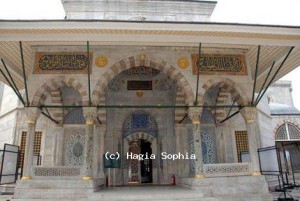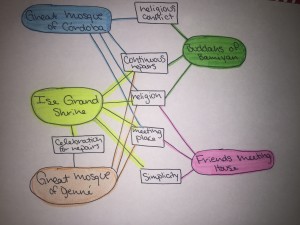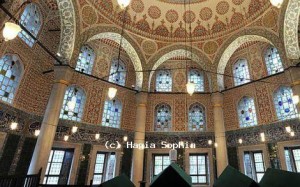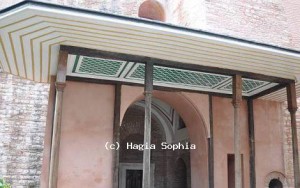All of these structures are working to keep up with current times. May the work being done being pure restoration on the buildings or the sculptures, or dealing with different religions wanting to use the grounds or wanting to get rid of them.
Mausoleums and Turbes
A mausoleum is a free standing building that acts as a resting place for the deceased, it is common to have multiple people kept in these buildings. In close relation to a mausoleum is a turbe mausoleum, turbe is the Turkish word for tomb, these buildings are often much smaller in comparison.
There are five turbes on the Hagia Sophia property that belong to the Ottoman Sultans, their family members, and those close to them. Before the Hagia Sophia became a museum it last served as a mosque. The tombs hold from four people to 54 people. With the largest turbe, Sultan Murat III chose to house his wife, his daughters and princes, along with other courtier women. In the smallest tomb are four of Sultan Murat III’s princes and a daughter. Some of these tombs were built specifically for the men they are named after, and others had been converted to tombs after death.
Every tomb that was built, or converted, has its own unique appearance. From the exterior the Tomb of Sultan Mastafa I (pictured above) seems to be the most conservative. This tomb acted as a storage space for lamp oil before being converted to a tomb. One of the grander tombs belonged to Sultan Selim II (seen below). A special architect, Sinan, was called to complete this building, and it was was completed three years after Selim II’s death. The outside of the tomb has grand arches, with gold accenting on the columns. Every tomb has hand decorated art and ornaments throughout.

Sources:
http://www.hagiasophia.com
http://ayasofyamuzesi.gov.tr/en
Photos from:
http://www.hagiasophia.com
Part I
I felt like all of the articles were very similar, but the one that was closest to what I learned in elementary school was “The Pilgrims and and America’s First Thanksgiving” on holiday.net. The article that is closer to my understanding of Thanksgiving now is from National Geographic, the article went on to debunk any myths that I had learned growing up and it spoke about how the peace between the two groups of people had ended. I now know that there was ton of animosity between the settlers and the natives. Growing up I had always seen the first Thanksgiving as complete happiness and it set the tone for good relations throughout history. I now know that is not the case and there was turmoil between the two groups. Instead of the holiday being about fun crafts, good food, and getting time off of school I know see it as a time to gather with my family and reflect on those who I am grateful to have.
Part II
I enjoyed reading their interpretations of the first Thanksgiving. I don’t think they completely discredited my views of Thanksgiving but gave me a more of an understanding of what the migrants could have been feeling. Most of the articles spoke about how collectivism was not working, and having to raise food for your own family to survive caused the people to work harder. After having to deal with the frustration of doing work, while someone else did not do the same it would make sense that this is a reason that they wanted to show their thanks for what they had because it took awhile to get to that point.
When reading what Rush Limbaugh had said on his radio show it was apparent that he was dramatic with the way he presented what he had to say. Upon further research of him it was obvious that he speaks about his viewpoints in a very controversial manner. In Del Tackett’s article on the same subject, he was the only one to actually quote the Bible. This does not steer me away from his ideas anymore than I would have been. On Tackett’s website he speaks about God often, so it makes sense why he would be leaning towards the religious aspect of their decisions. I think both men come up with great ideas, and as long as the reader doesn’t bindingly believe everything that has been written down then I think the articles given are very helpful.
Part II
I don’t know if I would say this set of articles were more interesting than the last set, but they were more impacting. The articles came from a place where it spoke about how modern day Thanksgiving depiction can kind of suppress the current culture of Native Americans. These interpretations are enough for me to reevaluate how I had celebrated the holiday in the past. I had always known that the single depiction of Native Americans was inaccurate but I never thought about it as limiting. By showing these large diverse group of people in one single way with one single culture is wrong and offensive to the people apart of these groups. Knowing that the authors aren’t coming from a disrespectful sense makes me respect the writer. The man who was asked to speak at the Thanksgiving celebration touched me the most, he had seen the many ways this generalization of his people can do to hold people back. It didn’t completely change my thoughts on the holiday but made me step back and think about how these actions effected people.
Part IV
If a historian were trying to make sense of the first Thanksgiving I think they would try to learn about the event from all different sides of the story, not just one group of people’s accounts. In this current time, I think it would be very important for the historian to do their research and make sure to not get stuck into any stereotype.
In order for an 18 to 30 year old to decide which interpretation of the first Thanksgiving was the most compelling would be the store they are likely to not have heard before or a story that aligns with their personal beliefs. Personally, I find it really compelling to see a different side of a story, rather than one that I had heard many times. But on the contrary it can lead to it being a harder time to stay interested when it is not easy to follow where the story is going.
To find primary and secondary sources on this topic I would take to the Albertson’s Library page to begin my search. If I were not find the specific information I was needing, this would be a good starting point to gather some keywords and ideas to help me continue my search on Google or GoogleScholar.


